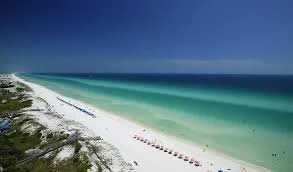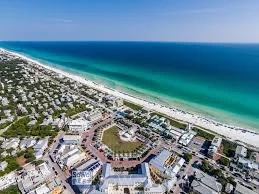South Walton
South Walton is a picturesque region in northwest Florida, celebrated for its 26-mile stretch of sugar-white sand beaches and stunning turquoise waters along the Gulf of Mexico. Initially settled by Native American tribes like the Muscogee and Euchee, the area saw its first permanent English-speaking residents with the arrival of British settlers in the 1700s. By the late 19th and early 20th centuries, Grayton Beach emerged as the first established beach community, founded in the mid-1880s. The region's economy was initially driven by the timber and naval stores industries, with early coastal life being quite remote due to difficult road access and the large Choctawhatchee Bay acting as a natural barrier. It wasn't until the 1930s and 1940s that infrastructure like bridges over the bay and Highway 98 began to connect South Walton to the rest of the world. The development of the scenic Highway 30A in the mid-20th century ultimately paved the way for the unique coastal communities that define the area today.
The development of Scenic Highway 30A gave rise to 16 distinct beach neighborhoods, each with its own character and style. The 1980s saw the emergence of New Urbanism, a development philosophy that shaped communities like Seaside, Rosemary Beach, and Alys Beach with a focus on walkability, classic architecture, and community gathering spaces. Other communities include the upscale and lush Rosemary Beach with its cobblestone streets, the casual and bohemian Grayton Beach, and the family-friendly Seagrove Beach. Several communities, including WaterColor, Sandestin, and Miramar Beach, offer a mix of amenities from upscale shopping and dining to world-class golfing. The distinct personalities of these neighborhoods are a major draw for visitors, offering a variety of experiences in one continuous stretch of coastline.
For visitors and residents, South Walton offers a wide array of activities that blend outdoor recreation with a vibrant cultural scene. The natural environment is a highlight, with four state parks—including Grayton Beach and Topsail Hill Preserve—offering miles of trails for hiking and biking, kayaking, and paddleboarding on the rare coastal dune lakes. The 19-mile Timpoochee Trail provides a paved path for cyclists to explore the scenic coastal route. Beyond the beach, the area features a thriving art scene with numerous galleries, boutiques for shopping, and a diverse culinary landscape with a focus on fresh Gulf seafood. Events like the 30A Wine Festival and weekly farmers markets contribute to the lively atmosphere, ensuring that there is always something to do in South Walton.
South Walton's coastal dune lakes are a rare and unique geographical feature found in only a few places in the world, including parts of Australia, New Zealand, and Madagascar. Fifteen named coastal dune lakes dot the 26-mile stretch of coastline, and their unusual characteristics are central to the region's distinct ecology.
Intermittent Gulf connection
The most defining and unique feature of these lakes is their infrequent, temporary connection to the Gulf of Mexico.
Outfalls: Separated from the Gulf by a natural sand berm, the lakes are primarily fed by freshwater sources like rain, streams, and groundwater seepage. When heavy rain or a storm surge causes the water level to rise, it can breach the sand dune and create a channel, or "outfall," that flows into the Gulf.
Brackish water: This process, known as a "blow-out," allows saltwater, along with marine plants and animals, to flow back into the lake. This exchange creates a dynamic, brackish ecosystem with varying levels of salinity, making each lake a one-of-a-kind habitat.
Unique biodiversity: This variable salinity supports a rare and diverse ecosystem where freshwater and saltwater species coexist, creating a critical habitat for a wide variety of plants and animals.
Distinctive ecosystem and appearance
Beyond their connection to the Gulf, several other characteristics set these lakes apart:
Tannin-rich water: The water in the lakes often has a tea-like or dark brown color. This is not a sign of pollution but rather the result of tannins, naturally occurring organic matter from decomposing leaves, bark, and grasses.
Shallow and naturally formed: The lakes are unusually shallow, averaging only about five feet deep, and were formed by winds and waves thousands of years ago.
Dynamic and evolving: The intermittent outfall events and constant shifting of sand dunes mean the lakes are perpetually evolving, with their shoreline, depth, and character changing over time.
Significant ecological role
Filters and habitats: The coastal dune lakes act as important natural estuaries and nurseries, providing a unique habitat for a wide array of species, including various fish, birds, and other wildlife.
Water management: They play a vital role in the health of the coastline by storing and filtering water.
Conservation efforts: Due to their rarity and ecological importance, conservation efforts, such as those led by the Choctawhatchee Basin Alliance and the Coastal Dune Lakes Advisory Board, are in place to protect and preserve them.




